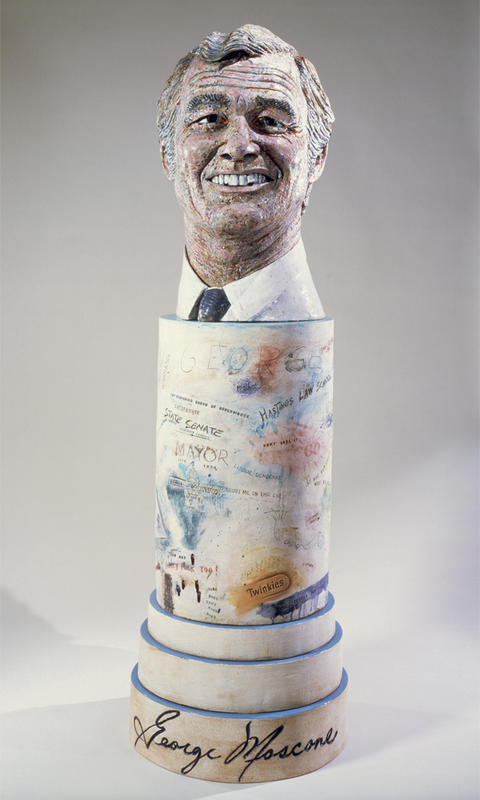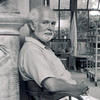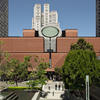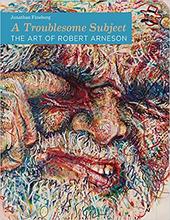More about Portrait of George (Moscone)
- All
- Info
- Shop
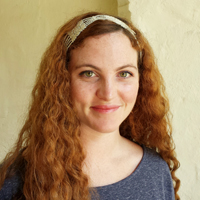
Sr. Contributor
Everyone remembers Harvey Milk, but we remember George Moscone as the man who figured out that diversity was a good thing before anybody else.
San Francisco. November 27, 1978. The significance of this day may be lost on young San Franciscans and transplants, but it is nevertheless a date that remains with them. Reminders of the City Hall Slayings linger as two names embedded on memorials barely visible through the fog. Those beyond the Barbary Coast have probably heard of Harvey Milk. As the first openly gay person to be elected to public office in California, his murder on that fateful day made him a martyr for the gay rights movement. Less remembered nationally is the first man shot. This man helped put Milk, along with numerous women and minorities in office. As an early proponent for gay rights it was he who repealed California’s sodomy law. As a senator he introduced a school lunch program in California, fought for the rights of the poor and working class, and kept the beloved Giants from moving to Toronto. He was also linked to voting fraud and sex scandals connected to cult leader Jim Jones. His name was George Moscone, Mayor of San Francisco from 1976-1978, and the controversial bust is the perfect tribute to his complex legacy.
When Portrait of George (Moscone) was revealed in 1981 as the honorific centerpiece for the Moscone Convention Center it was met with cries of outrage. At first glance it’s difficult to see why. Perhaps Arneson’s bust isn’t the most flattering of the mayor (his teeth are crooked and he looks a little goofy) but surely people expected something a little funky from the man who founded funk art? The problem wasn’t in the bust, but in the proverbial root, or in this case pedestal, of the sculpture. After getting approval for his design which included a blank ceramic column Arneson was inspired to inscribe the base with images and phrases cataloging Moscone’s life.
The controversy wasn’t stirred by what you’d think. The artist made no mention of the tainted 1975 mayoral election in which Jim Jones of the People’s Temple admittedly bused his followers to San Francisco to vote for Moscone using the names of dead residents. Also not inscribed were drawings of Moscone at Temple parties having extramarital affairs with supposedly underage Temple members or looking the other way while Jones abused his newly gained power as Chairman of the San Francisco Housing Commission. Nor was mention made of the final White Night (what they called their mass suicide drills) of Jonestown. Held on November 18th, 1978, just nine days before Moscone’s death, this event resulted in the death of 909 Americans. No, what caused an uproar was not Arneson’s depiction of events in the Mayor’s life, but his death.
Here are a few of the offending engravings:
- Bullet holes: Arneson pockmarked the column with several bleeding bullet holes referencing Moscone’s assassination at the hand of Dan White. White, a cop who’d given up the badge in order to become a City Supervisor saw himself as “defender of the home, the family and religious life against homosexuals, pot smokers and cynics.” Stating that he wasn’t making enough money, White resigned from his position on November 10, 1978, a decision he almost immediately tried to reverse by pleading with Moscone.
- A Smith and Wesson gun: On November 27th White snuck into City Hall through a basement window to avoid the metal detectors and shot Moscone in his office with a Smith and Wesson gun.
- “Bang Bang Bang Bang”: Moscone was shot four times, once in the shoulder, once in the chest, and twice in the head.
- “Harvey Milk too": White then went across the hall and shot Harvey Milk to death.
- A Twinkie: White and his lawyers fought for a lesser charge by invoking what is now famously known as “the Twinkie defense.” His defense claimed that White was depressed by losing his job and as a symptom of that depression began eating unhealthy food which had contributed to his inability to think clearly. Though Twinkies were never actually mentioned in court, the phrase is commonly used to refer to an unlikely defense.
As silly as the defense may seem, it worked. White was sentenced not to murder in the first degree, but voluntary manslaughter… which meant only seven years in prison. He served five years before being paroled and killed himself two years later. Citing homophobia and corruption in the court system, citizens were outraged by the light sentence and as so often happens, demonstrations became riots. The White Night Riots (a chilling coincidence) took place on May 21, 1979 and are now heralded as the turning point for pro-gay politics in San Francisco.
Alright, Arneson’s desire to relay everything about Moscone’s biography may have been a little insensitive two years after the obviously very dark events surrounding his death. Moscone’s son Christopher commented, "It was a slap in the face to me, my mother, and brother and sisters […] just not appropriate for public art.” It was decided that the piece was not fit for display and after Arneson refused to make alterations it was returned to him and sold to a private collector.
In 2012, 30 years after it went out of the public eye, SFMOMA acquired the work, saying it was “one of the most iconic, important works that Arneson ever made.” Even Christopher Moscone has approved of the acquisition stating, “With the passage of time, I think this is probably a good place for it now.”

